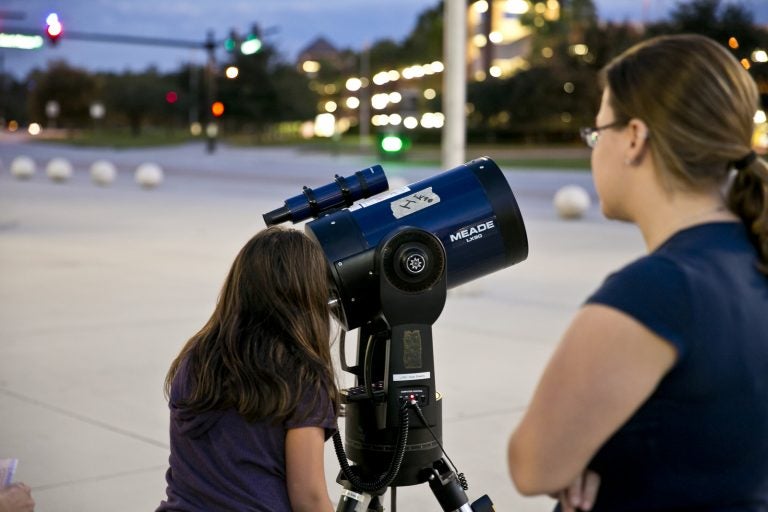UCF’s Planetary Sciences Group will host a telescopic-viewing night of the moon in a new location Thursday, Dec. 8 . For the first time, telescopes will be set up from 5:30 to 8:30 p.m. in front of Millican Hall near the Reflecting Pond.
Hurricane Matthew interfered with the originally scheduled event in October, which coincided with International Observe the Moon Night. But organizers wanted to make sure the community had an opportunity to get a close view of the night sky before the university’s winter break. The viewing normally is held at the Robinson Observatory on campus.
If the weather cooperates, the moon, Venus and several other planetary bodies will be visible through the telescopes. Check the group’s Facebook page for weather updates, especially if rain sneaks into the forecast.
The event is just one of the many events the Department of Physics group coordinates. It also hosts a student-run Astronomical Society, weekly seminars, and biweekly “Knights Under the Stars” sky viewings at the observatory, which are open to the public.
Yan Fernandez, director of the observatory and a physics associate professor, said the program’s mission is one of education and outreach to share the wonder of the stars with the world at large.
“I feel like it’s part of the overarching mission of a university to educate people to become better citizens, and that means knowing something about lots and lots of things,” Fernandez said. “Astronomy is well-placed for that because it’s easy – compared to some other sciences – to draw people in thanks to that gee-whiz factor. You can show them pretty pictures from the Hubble Telescope, for example, but then they can come down to the observatory and see these things with their own eyes.”
The Robinson Observatory on the main campus was established in 1995 after members of the Central Florida Astronomical Society discovered a 26-inch Schmidt-Cassegrain telescope in storage in Gainesville, according to the Planetary Sciences Group website. Orlando benefactors Herbert and Susan Robinson helped raise half of the $500,000 necessary to build an observatory to house the telescope, where it resides to this day.
“It’s a good training ground for some of our graduate students,” Fernandez said. “It’s a good place to get a feel for how data collection and experimental methods in astronomy actually work before they get into the professional world.”
“I love looking through telescopes,” said Zoe Landsman, a Ph.D. candidate in planetary sciences who works as a graduate teaching assistant at the observatory.
“Being able to see the rings of Saturn or Jupiter’s moons with my own eyes is amazing, and I love the excitement in other people’s eyes, in the visitors who come to the observatory and see those same things. I enjoy being able to foster that appreciation, especially in the younger generation when they first see these objects magnified and close up.”
It’s that sense of amazement that caught the attention of Jeff Jorges, president of the astronomical society and a senior physics major. He and the club members regularly host events at schools, where they teach elementary and middle school students how to use telescopes and how to identify constellations.
“There’s a social element to the club of people being together and talking about their interests, there’s an outreach element where club members help out at local events and there’s a teaching element where, even if you don’t know anything about astronomy, you can come and have fun and learn something,” Jorges said.
Every year, the society launches a weather balloon bearing a payload of cameras and sensors into the upper atmosphere. Since the balloon is at the mercy of Earth’s prevailing winds, the team has to examine atmospheric data the day of the launch to determine roughly where their payload will land after descending from heights of around 85,000 feet. This year, the society is attaching a device called Tracksoar that will provide telemetry data such as altitude, pressure and temperature readings while still in flight.
“It’s definitely one of our more popular events,” Jorges said. “We spend nearly a year planning each launch. It’s really rewarding to build something from scratch, to send it up and to retrieve it and have video proof, like seeing the curvature of the Earth, to show for our efforts.”
